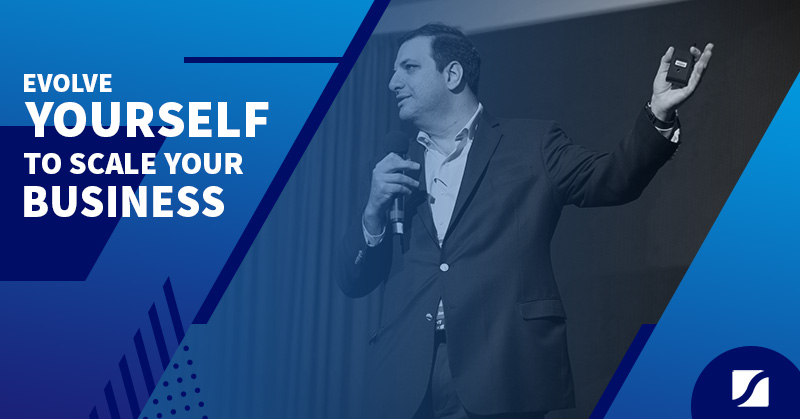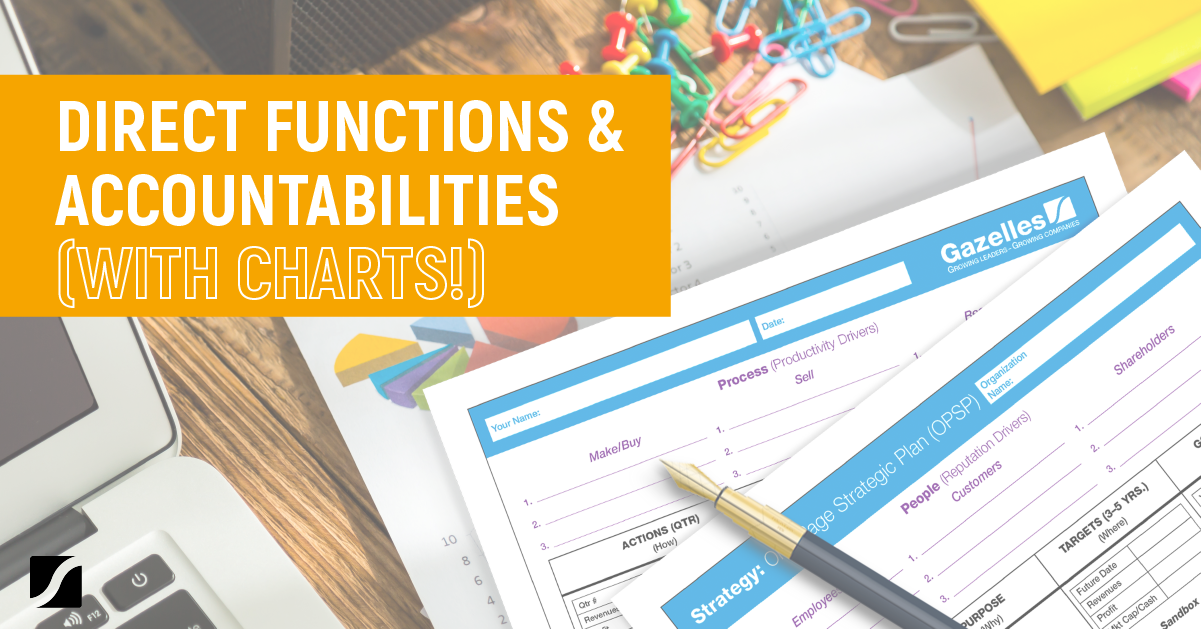Evolve Yourself to Scale Your Business

Fast forward to today: After multiple companies and years of experience as a CEO / CEO coach helping other entrepreneurs grow, our company, Growth Institute, was ranked in the Inc. 5000 list. I am incredibly thankful to everyone that helped us grow to this milestone.
And to pay it forward, I hosted a webinar training to share the same roadmap we used, so you too can grow your business with less drama, less stress, and less work. When it comes to business growth, there are two types of companies:
- Companies that are growing really fast but face a lot of drama and complexity.
- Companies that are stuck and want to start growing fast.
It might seem like they are in different situations, but they’re actually in the same boat. They both have scaling problems.
Let’s start with an overview of the four stages of growth.
4 Stages of Growth
The four stages is a roadmap that guides how your focus, priorities, and key decisions will change as your company grows. The roadmap will prepare you for the barriers you will face and the new skills you need to develop to overcome them.
Here is an overview of the four stages of scaling up:
- Startup: 1-5 employees
- Grow up: 6-15 employees
- Scale-up: 16-250 employees
- Dominate your industry: 250+ employees
Why do we categorize these stages in terms of employees and not revenue?
The first reason is that revenue and success can vary across different countries. The second reason is the fact that an increase in revenue doesn’t lead to complexity, people do.
Before we dive into what to expect at each of these four stages, here’s something interesting you should know. In order to go from one stage to the next, you have to unlearn everything you learned that got you to that first stage, and then relearn new things to get you to the next one.
Think of it like driving a car. Once you reach a certain speed, the gear that got you there will not get you to the next level of speed. You need to shift gears. If you don’t, your engine will burn out.
The Dynamic Growth Model
For a company to scale to 5, 10, or even 100 million in revenue, you need to understand what to expect at the four stages of scaling up, and how to shift gears from one stage to the next.
Shifting through these four stages is what we call the dynamic growth model. Let’s now look into each stage of the dynamic growth model so you understand the priorities and barriers of each stage, plus the key decisions you need to make to go to the next stage.
Stage 1: Startup:
At this stage, you are just starting up with 1-5 employees.
Priority: Product development.
Focus: Validating your business model.
You really need to understand your business model, and this goes beyond simply having a business plan outlined on paper. This includes talking to clients, understanding how to adapt your business plan as you learn more about your clients, and validating your business plan with the market reality.
Barrier: Market dynamics.
It’s important to understand the market, and we believe research is a key tool for you to achieve this.
Ability: Marketing.
Marketing is a way of communication with your potential buyers and connecting with them. You never truly understand how to market until you are on the ground, trying to sell your product and service.
Decision: Strategy.
At this stage, getting your strategy right is crucial so that you can scale. Your strategy needs to take into account your product development, validated business model, and market dynamics.
Stage 2: Grow up:
At this stage, you have grown to 6-15 employees. You have fixed expenses such as salaries and rent. This is a discovery stage where an entrepreneur ages the most. It’s the most painful stage because you begin to face a lot of cash flow problems and leadership problems.
Focus: 100% sales.
Priority: Hire the right team.
In Stage 1, you don’t really choose your employees because you are not able to offer an attractive salary or attract people with a good brand. So at Stage 1, your employees actually choose you.
By the time you reach Stage 2, you need to switch gears. Now, you are choosing your employees. You have to be more selective of who you hire, and have clarity of their role.
Barrier: Leadership.
In Stage 1, the entrepreneur wears multiple hats — from administration to technical work, accounting and more. At Stage 2, you have to become a leader.
Ability: Delegate, predict, repetitiveness
As a leader, you now need to know how to delegate, setting up systems and procedures, and leading your team to help you grow the company.
Decisions: Cash and team.
As mentioned earlier, this is the stage you begin to face cash flow procedures now that you have fixed expenses. Thus, your key decisions will revolve around managing cash flow and hiring the right people who can grow your business.
Stage 3: Scale up
This is where you really begin scaling at 16-250 employees. The engine that you built in the previous stages has mostly been put together manually, so it begins to fall apart at this stage. You need to start investing in infrastructure to speed up your business growth.
Focus: Define industry.
Priority: Scale.
Before this stage, nobody in the industry really considers you a competitor because you’re too small. Once you reach this stage, others are going to seriously compete with you, so your focus is on getting the basics to be able to scale.
Barrier: Infrastructure.
In Stage 2, it doesn’t matter how complicated your operations are as long as it works. Once you have grown, it becomes more important to simplify your operations.
Ability: Align and simplify.
You can’t have 10,000 people go through a complex process because it will cost you more money and create more drama.
Decision: Execution.
Companies that die in this stage were not able to handle their execution correctly or well. Your decisions need to be focused on building a well-oiled machine that simplifies execution.
Stage 4: Dominate your industry
This is the stage where you really begin to matter in the industry. With over 250 employees, you have an established brand, you are beginning to win market segments, and salaries are getting fat.
Focus: Dominate your industry.
Priority focus: Constant reinvention.
With bigger salaries, it’s easy for the organization to get into a comfort zone that can lead to a plateau or decline. That’s why constant reinvention and innovation are important to continue growing.
Barrier: Comfort zone.
Constant learning is pivotal in order to get your team out of the comfort zone and create new innovations.
Decisions: All 4 decisions of scaling up (People, Strategy, Execution, Cash)
Companies usually grow in a spiral. To reach the next level, you have to build a new base. Then you go up, and build another new base, like a spiral. Rotating between the four decisions of scaling up will help you build one new base after another.
The Leadership Evolution
As your company grows through the four stages of scaling up, you — the business leader — has to evolve from entrepreneur to CEO. Here’s what that evolution looks like:
Stage 1: You wear multiple hats. You could be juggling product development, technical work, selling, marketing — or even cleaning the restrooms. The people around you supporting you, but you are still doing the core work of everything.
Stage 2: Now, you have to step up to be a leader who delegates and defines direction. At this stage, you are leading people one-to-one, which is fairly easy because you can take the person out to lunch or dinner and really go deep into guiding them.
Stage 3: At this stage, you don’t have time to be a one-to-one leader and your role as a leader becomes significantly harder. A great analogy is at Stage 2, your leadership role is like playing checkers, but at the third stage, you are now playing chess.
What does this mean? Well, in checkers you only have red or black pieces. You can move the pieces however you want. But in chess, each piece of your team is now different with varying strengths and weakness. You have to be so much more strategic with what position you place each team member to leverage their strength while covering their weaknesses.
At this stage, you also need to develop the skill of coaching to help your team become the best team players they can be, which includes improving communications too.
Stage 4: Finally at the fourth stage, you become like a satellite around your organization. The day to day operations can run smoothly without you. Your role is now more of a strategic innovator and change catalyst that sets the right culture. Your key focus is to create a culture of growth and innovation to get the team out of the comfort zone, keep up with trends and innovations you have to build in your company, and consistently dominate your industry.
The Freedom Formula
If you apply the dynamic growth model roadmap and you commit to evolve as a leader, it is almost certain you will see results. However, what is not certain is you whether you will have the work-life balance you enjoy.
That’s why it is not uncommon for me to receive calls from entrepreneurs saying, “Hey, I haven't gone on vacation for four or five years, or seven years”; or , “I love my company. I love what we're doing I'm so excited, but I really don't have a life. I don't even have time to watch my kids grow up.”
How do you make sure you don’t get trapped by your business?
The freedom formula is having an exit plan. That’s why I often tell people, “The best thing you can do if you want to grow your company is to build a company that can run without you.”
Here’s what this means. Your goal, at every stage of growth, is to get your company ready for an exit — EVEN if you don’t want to sell it.
Why is this important? Because it will guide you to put the right systems, procedures, and people in place that become an asset with an intrinsic value on its own. Which means the asset is worth something, even without you.
This is the real secret to rapidly scale up and still have a life, without all the drama.
Summary
In summary, to overcome the challenges of scaling, you need to focus on three strategies:
- Understanding the dynamic growth model and how to shift gears across the 4 stages of scaling up.
- Constantly sharpening your leadership skills so you can step up to meet the evolving role of a leader as your company grows from stage to stage.
- Create an exit plan — EVEN if you don’t want to sell your company — so that you are never trapped by your business and can enjoy freedom in business and in life.
It’s important you don’t do this alone. As they say, it can be lonely at the top where nobody understands the challenges you face and the decisions you have to make.
That’s why we created Master of Business Dynamics All Access (MBDAA), so CEOs and business leaders like you have the frameworks, guidance, support, and community you need to scale your business with less drama, less stress, and less work.



